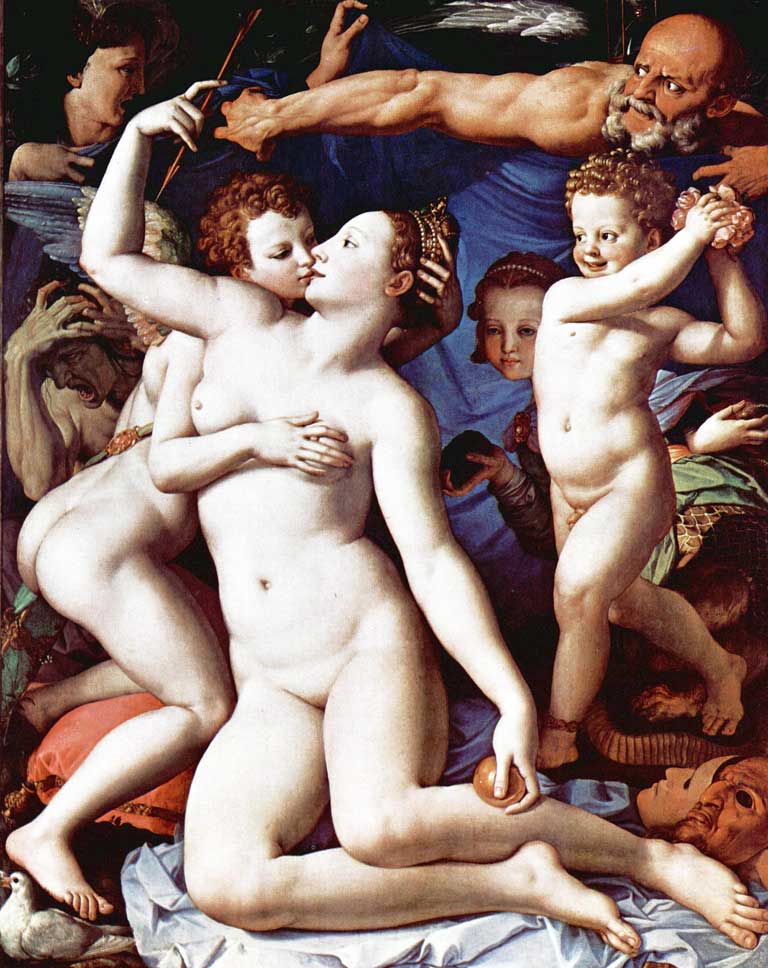Great Works: An Allegory with Venus and Cupid, By Bronzino
National Gallery, London

Bronzino, son of a Florentine butcher, court painter to Cosimo I de Medici, could be such a tease. The fact is that we seldom know quite know where we are with him. He possesses this quality of brilliantly polished evasiveness. His religious paintings are often almost too erotically glamorous for words. We would die all over again for his dead Jesus.
His portraits of members of the court, gorgeously adorned adults or plump-cheeked babes, are too glacially reserved for us ever quite to know what he is thinking about his sitters. Is it liking or loathing? He lacks human warmth, you could say. He doesn't feel for his sitters as Rembrandt felt for his. He is intellectually removed. He scorns or inwardly mocks just as much as he preens and flatters.
But he has so much else by way of compensation. Is it a kind of moral perversity? Perhaps. (He wrote amazingly filthy poetry.) And one of his greatest attributes is this ability to force us to forever be holding our judgements in the balance, never, finally, to go for one thing or the other. This allegorical painting on the familiar theme of the ongoing dalliance between Venus and her naughty son Cupid seems to be pointing a fairly stern moral of sorts, which could be this: always be mindful of what is going on behind your back. Never trust seeming. At the same time, it is offering up to us eroticism on a gilded dish, complete with the billowing of gorgeous fabrics, pink, blue, green, yellow. It is all so pleasing to the eye, every element of this grand, peackockish display. It is also quite slippery and malign. Beneath all the suave sheen of its surface glamour, there are bestial gruntings and heavings.
It calls itself an allegory, and immediately, in our pursuit of the elusive meanings of that word, we find ourselves thinking forward just a few decades to a great literary allegory written by the English poet Edmund Spenser called "The Faerie Queene". That long, unfinished poem teems with allegorical personages – Lady Una, Gloriana and the rest – whom we never really get to know because they are nothing but uncomplicated embodiments of their moral attributes. Yes, to call something an allegorical figure is to rob it of its full human richness – and I mean by that its inward richness because allegorical figures are allowed to be rich on the surface. Spenser, in fact, is little other than bewitchingly glorious surface adornment. And so it is in this painting too. There is this wonderful surface of bewitchingly twisty carnality – but these are not human beings that we are seeing before our eyes. They are weirdly phantasmagorical embodiments of what they represent in the scale of good and evil.
This is perhaps one of the reasons why we finding ourselves puzzling so much over the fact that they don't quite work as fully realized human figures – and we want them to do that because, in certain respects, this seems to be a shamelessly glamorous presentation of near-perfect youthful bodies that we are being invited to sip at, visually. And yet it is not. It is too dreamlike in its play of distortion. We could propose that this is the consequence of Bronzino having bitten off more than he could chew, that he did not quite possess the painterly expertise to get this enormously complicated composition quite right. (This is his first attempt at the theme. The second, in Budapest, is much more straightforward and academic in its approach.) That's nonsense though – he was simply too great a painter. So, finally, he has us on the end of a spit, and, quite gently, he turns it. What a tease.
About the artist: Agnolo di Cosimo di Mariano
Agnolo di Cosimo di Mariano (more familiarly known by his nickname of Bronzino) was born in a suburb of Florence in 1503. His paintings, supremely aristocratic and formal in manner, seem to embody the icy splendour of the Medici court of Cosimo I. In addition to his painting, he also had great talents as a poet, and he was a member of the Accademia Fiorentina.
Subscribe to Independent Premium to bookmark this article
Want to bookmark your favourite articles and stories to read or reference later? Start your Independent Premium subscription today.

Join our commenting forum
Join thought-provoking conversations, follow other Independent readers and see their replies